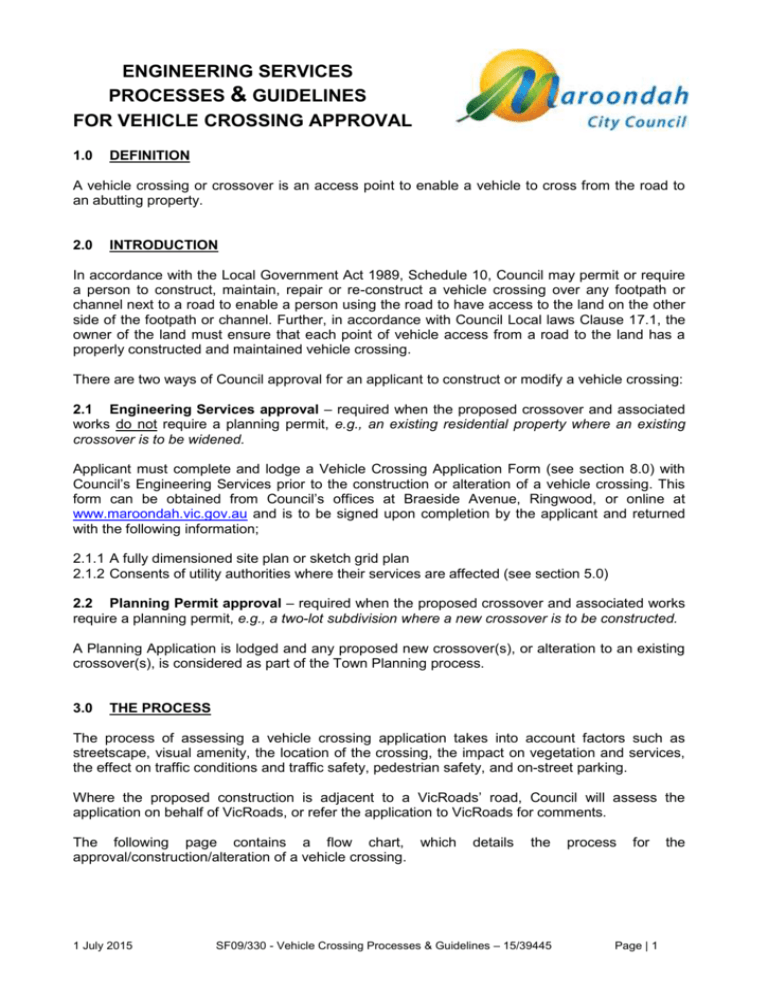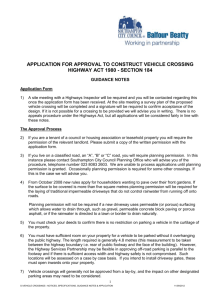Doc, 264Kb - Maroondah City Council
advertisement

ENGINEERING SERVICES PROCESSES & GUIDELINES FOR VEHICLE CROSSING APPROVAL 1.0 DEFINITION A vehicle crossing or crossover is an access point to enable a vehicle to cross from the road to an abutting property. 2.0 INTRODUCTION In accordance with the Local Government Act 1989, Schedule 10, Council may permit or require a person to construct, maintain, repair or re-construct a vehicle crossing over any footpath or channel next to a road to enable a person using the road to have access to the land on the other side of the footpath or channel. Further, in accordance with Council Local laws Clause 17.1, the owner of the land must ensure that each point of vehicle access from a road to the land has a properly constructed and maintained vehicle crossing. There are two ways of Council approval for an applicant to construct or modify a vehicle crossing: 2.1 Engineering Services approval – required when the proposed crossover and associated works do not require a planning permit, e.g., an existing residential property where an existing crossover is to be widened. Applicant must complete and lodge a Vehicle Crossing Application Form (see section 8.0) with Council’s Engineering Services prior to the construction or alteration of a vehicle crossing. This form can be obtained from Council’s offices at Braeside Avenue, Ringwood, or online at www.maroondah.vic.gov.au and is to be signed upon completion by the applicant and returned with the following information; 2.1.1 A fully dimensioned site plan or sketch grid plan 2.1.2 Consents of utility authorities where their services are affected (see section 5.0) 2.2 Planning Permit approval – required when the proposed crossover and associated works require a planning permit, e.g., a two-lot subdivision where a new crossover is to be constructed. A Planning Application is lodged and any proposed new crossover(s), or alteration to an existing crossover(s), is considered as part of the Town Planning process. 3.0 THE PROCESS The process of assessing a vehicle crossing application takes into account factors such as streetscape, visual amenity, the location of the crossing, the impact on vegetation and services, the effect on traffic conditions and traffic safety, pedestrian safety, and on-street parking. Where the proposed construction is adjacent to a VicRoads’ road, Council will assess the application on behalf of VicRoads, or refer the application to VicRoads for comments. The following page contains a flow chart, which approval/construction/alteration of a vehicle crossing. 1 July 2015 details the SF09/330 - Vehicle Crossing Processes & Guidelines – 15/39445 process for Page | 1 the PROCESS FOR THE APPROVAL/CONSTRUCTION/ALTERATION/REMOVAL OF A VEHICLE CROSSING Application for a vehicle Crossing completed and lodged with Council’s Engineering Services Town Planning Application lodged, with details of proposed crossover works Assessed in accordance with Engineering guidelines Proposed crossover works assessed in accordance with Engineering guidelines, as part of the Town Planning process Application approved with conditions. Letter of Approval issued (valid for 12 months). Application refused. Letter issued with reasons for refusal Crossover approved through the issuing of a Town Planning permit Town Planning Permit refused Vehicle Crossing Permit to be obtained from Council offices, located at Braeside Avenue, Ringwood, at a fee of $198.00. Applicant to show Engineering Letter of Approval or Planning Permit with approved plan when taking out permit (valid for 30 days). Boxing/Crushed Rock/Setting of Levels/Compaction (with appropriate Traffic Management) to be undertaken and then inspected by Council (Preliminary Inspection). 24-hour notification is required. Inspection Passed Inspection Failed Rectify Failure Surface material laying/finishing works (with appropriate Traffic Management) to be undertaken and then the final inspection to be carried out by Council (24 hr notification required). Nature Strip/Kerb and Channel to be re-instated prior to Inspection FINAL INSPECTION PASSED 1 July 2015 Final Inspection Failed SF09/330 - Vehicle Crossing Processes & Guidelines – 15/39445 Rectify Failure Page | 2 4.0 GUIDELINES FOR APPROVAL The following is a summary of the standard guidelines that apply for approval of construction works associated with vehicular access to a property: Construct standards for vehicle crossings Set Levels Modification of existing vehicle crossing Double vehicle crossings Saw cutting Kerb and Channel Reinstatement Redundant vehicle crossings 1 July 2015 The proposed works must be constructed in accordance with Council’s standard drawings (ie SD-H03 – SD-H05). Where the proposed construction is adjacent to a Council road that does not contain concrete kerb & channel on that particular side of the road, a crossover with culvert, in accordance with Council’s standard drawing SD-H04, may be constructed. If a vehicle crossing is constructed on a road with an existing footpath, the levels are set to match the existing footpath level. However, if a footpath doesn’t exist, the vehicle-crossing is to be constructed to set levels as provided by Council’s Engineering Services Department. Note: Council will only allow widening of vehicle crossing if the existing vehicle crossing is constructed to Council’s current standards (with reinforcement etc) and is in a good condition to Council’s satisfaction. Otherwise the vehicle crossing must be fully reconstructed. If the proposed works are within 1000mm of any nearby vehicle crossing (ie neighbouring properties), then the area in between the crossings must be fully constructed to form a double-crossing to Council standards. When constructing a double-crossing, saw cut and dowel into the existing section of crossing using Y-12 reinforcement bars. Note: Council will only allow widening of vehicle crossing if the existing vehicle crossing is constructed to Council’s current standards (with reinforcement etc) and is in a good condition to Council’s satisfaction. Otherwise the double crossing must be fully reconstructed. When constructing a new vehicle crossing, the existing sections of kerb & channel must be cleanly saw cut at the edge of the road surface, removed, and replaced with a standard channel and layback section, in accordance with Maroondah City Council standard drawings. The kerb and channel must also be cut between the section to be removed and the section remaining. Damaged road pavement must be repaired to Council’s satisfaction. Upon completion of the works the reinstatement of nature strips, kerb & channel, and any other disturbed areas, must be undertaken to Council’s satisfaction. Any redundant vehicle crossing(s) must be removed prior to, or at the same time as the construction of the proposed works, and replaced with kerb & channel, in accordance with Maroondah City Council standard drawings. SF09/330 - Vehicle Crossing Processes & Guidelines – 15/39445 Page | 3 5.0 CLEARANCES/OFFSETS The following is a summary of Council’s standard minimum clearances/offsets for services or pits from vehicular crossings: Item Electricity Pole Light Pole Bracing attached to Poles (Stay Cable) Council Stormwater Pit Electricity Pit Fire Hydrants Other Service/Authority Pit Minimum Clearance (mm) 1000 1000 1000 1000 100 1000 1000 Where the minimum offset is not achievable: The applicant is required to contact the relevant service authority to obtain approval to either build next to the pit, or incorporate the pit into the proposed works. Permission may be granted for the existing stormwater pit lid to be replaced with a heavyduty gatic cover or similar, to accommodate vehicular traffic. 6.0 TREES/VEGETATION The following is a summary of the standard guidelines that apply for trees or vegetation adjacent to vehicular crossing works The proposed works must be located outside of the drip line of any adjoining trees, to avoid damaging the tree’s root system. Advice in relation to adjoining trees within the nature strip may be obtained from Council’s Team Leader, Arboriculture and Maintenance, on 9294 5680. If the proposed works facilitate access to a point that is currently blocked by a tree within private property, a planning permit may be required for its relocation/removal. Council’s Environmental Officer may be contacted on 9298 4423, to discuss possible removal requirements for trees within private property. 7.0 PEDESTRIAN SAFETY AND TRAFFIC MANAGEMENT During the construction process reflective safety tape or safety mesh and appropriate signage must be installed to provide adequate safety for pedestrians. Traffic management is the responsibility of the contractor, and must be undertaken in accordance with the Road Management Act 2004 – Worksite Safety – Traffic Management – Code of Practice and Australian Standards AS1742.3. Council’s inspectors may, at any time, ask to sight a traffic management plan. If a traffic management plan cannot be produced, or if the traffic management is deemed to be unsafe and not in accordance with Australian Standards, Council’s officers, in accordance with the Road Management Act 2004, may order the works to be stopped, and the site made safe. 8.0 FURTHER INFORMATION Vehicle crossing application forms and Standard Drawings can be obtained from Council Offices, Braeside Avenue, Ringwood, or downloaded in pdf format from the Council website at www.maroondah.vic.gov.au If further information is required, please contact Council’s Engineering Services department on 9298 4292, or email maroondah@maroondah.vic.gov.au 1 July 2015 SF09/330 - Vehicle Crossing Processes & Guidelines – 15/39445 Page | 4







